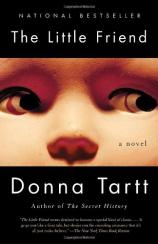The Little Friend
Review
The Little Friend
After a ten-year hiatus, Donna Tartt, author of THE SECRET HISTORY is back. THE LITTLE FRIEND, her long awaited second novel, exceeds all expectations. And, while we may never know the reasons for the wide gap between the two books, only the results matter . Suffice it to say, the lady has outdone herself, and her latest effort has been worth the wait.
The setting is Alexandria, Mississippi where the Dufresne/Cleve families, suffered a terrible tragedy that changed the course of their lives irrevocably. One Mother's Day, Robin, their nine-year-old son was murdered. "Mrs. Fountain saw him first." Her screams brought Charlotte Cleve Dufrense, his mother, running, "He was hanging by the neck from a piece of rope, slung over the low branch of the black-tupelo that stood near the overgrown privet hedge [that divided the Dufrense property from the Fountain's] he was dead."
The only possible "witnesses" to his murder were his younger sisters, Allison, who was four years old and the baby, Harriet. If they saw anything it was buried in the deepest recesses of their psyches, not to be recovered. For years the townspeople buzzed and gossiped speculating about who could be responsible for such a horrendous crime. Suspicion was everywhere and nowhere, and in the end, the investigation was dropped.
Robin's family never discussed his brutal murder; rather, they chose to remember him as a lively, lovable little boy, who brought joy to those whose lives he touched. hether or not their anecdotal remembrances were real was never an issue, "The Cleves chose to agree on some subjective matter -- [and] it became automatically and quite irrevocably -- the truth without any of them being aware of the collective alchemy which had made it so."
Harriet's mother never quite forgave herself for Robin's death and she withdrew into an "…indifference that numbed and colored every area of her life," and her older daughter, Allison, followed her into the same dreamy netherworld. Dix Cleve, the adulterous absentee father, moved to another state and only occasionally came home to visit.
But his absence transmogrified the Dufrense/Cleves into a matriarchal family whose driving force is Charlotte's mother, Edith, the children's fierce, no-nonsense grandmother. Edith's sisters make up the rest of the clan and they are Harriet's support system. They all live within walking distance of each other and when Harriet needs comfort or company she turns to her great aunts who welcome her kindly.
Tartt establishes all of this with languid prose that propels the reader into the action twelve years after Robin's death. Harriet, already a force a to reckon with is smart, snobbish, angry, manipulating, independent, fiercely loyal and very strong. She is a misfit among her peers, she doesn't share their interests, she is a scholar by nature and has only one friend, Hely Hull, a boy who idolizes her and would do anything for her.
Together the two pals devise a plan to avenge Robin's death. Harriet commits herself with obsessive tunnel vision to finding the killer. With snippets of unverified rumors she focuses her outrage on one man, which puts her and Hely in the center of a tangled web of danger, deceit, destruction and death.
Tartt's detailed depiction of the mores of life in a small southern town, with an underbelly as corrupt and dangerous as any urban center, throbs with pathos. She has given readers a provocative novel which is interesting and suspenseful; part murder mystery, part coming of age tale, part a child's story, part a story of loyalty and friendship, part an interlocutory on the American justice system, part a study in southern culture and mores, part a commentary on the little ways families chip away at themselves, especially in the face of tragedy or death, only to find their center implodes and leaves a haunting void in its wake.
Of the major motif Tartt says, "This is a book about children, but it's not a book for children. It's a frightening book. It's a scary book. It's fairly dark. It's about children coming into contact with adults … and coming into contact with the world of adults in a very frightening way." She also maintains, time and patience are the most important elements a writer must cultivate in order to do "it" perfectly. She admits that she writes slowly and says; too, "There are no real messages in my fiction. The first duty of the novelist is to entertain. It is a moral duty." And these beliefs, put into practice, is precisely what makes THE LITTLE FRIEND such a rich, passionate book in the spirit of Harper Lee's TO KILL A MOCKINGBIRD, while at the same time, it is imbued with the dark humor and loss of innocence vividly portrayed in HARRIET THE SPY.
THE LITTLE FRIEND is a treasure and readers can only hope that Ms. Tartt doesn't take ten years to produce another gem.
Reviewed by Barbara Lipkien Gershenbaum on January 22, 2011
The Little Friend
- Publication Date: October 28, 2003
- Genres: Fiction
- Paperback: 640 pages
- Publisher: Vintage
- ISBN-10: 1400031699
- ISBN-13: 9781400031696










